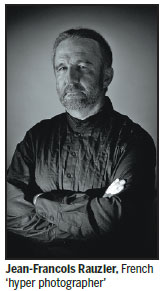

Jean-Francois Rauzier creates pictures using pictures.
The French artist goes beyond simply snapping photographs. He spends months assembling hundreds of tiny telephoto closeups into bigger mosaics that are up to 3 meters high.
The 63-year-old coined the word "hyperphoto" 15 years ago to describe the genre fusing photography, technology and art.
His creative process is dreamlike, he says. Hence the name of his upcoming show in Yunnan province's Dali, Looking for A Dream.
"Life is not easy. We need dreams," he says.
"The virtual reality I present in my photos is a dream based on reality, like a movie."
He spent a week in Beijing snapping more than 30,000 photos, from which he created four works. Among the 12 photos to be shown in Dali, one is of Beijing's hutong, and another is of an apartment building. He took those photos during his first visit to the city in 2012.
Beijing Babel renders a tall apartment building Rauzier created by piecing together thousands of photos of a buildings commonly seen in Beijing.
It's part of his Babel series, in which he creates similar images from shots he takes of residential buildings in cities he visits.
"A city's landscape can be vividly shown in an apartment building. There is a story behind every window," he says.
He jokes that his photos may enable people to see dishes on every family's dining table through every window of an apartment building.
"When I take quick shots, people are curious about what I do. I often tell them I work for Google Street," he says, laughing.
But while he creates images of ordinary buildings, Rauzier doesn't incorporate ordinary people into his works. He instead opts for celebrities.
His library series, for instance, depicts famous writers as readers in a library.
Architecture is a major theme in Rauzier's works.
He creates works portraying buildings like Gaudi's buildings in Spain, the Louvre and the Chateau de Versailles. A friend once complained that Rauzier cheated him because the real Versailles isn't as magnificent as what he saw in the photographer's works.
Rauzier says Beijing's Forbidden City is a great challenge for him. He says he isn't ready to create works based on it because the ancient palace is too intricate to render into a single image. But it gave him the inspiration he needed to create works based on Versailles and Angkor Wat, he says.
"Architecture in China is surreal. It's not easy for me to think out a good way to present it that's realistic and romantic," he says.
Rauzier plans to put his lens on Yunnan's Hani rice terraces, a UNESCO World Heritage site. He considers the fields to be a form of architecture built by famers over hundreds of years.
Initially, Rauzier's works all focused on landscapes. Before that, he was a commercial photographer, taking still-life shots of subjects like food.
His father and grandfather influenced his career. Rauzier's job combines photography and technology, he says.
His grandfather was a painter who portrayed the poor based on photos he took of them. Rauzier took his first picture at 13.
His father was a scientist. So Rauzier studied engineering in college.
When shooting a building, he divides into about 50 high-resolution photos of different parts.
Then he spends months creating mosaics based on these images on the computer.
The 63-year-old is now working on his gigantic panoramic hyperphoto of Paris, where he has lived for decades. The piece will take at least 20 years to finish, he says, because he's photographing and reconfiguring about 40 kilometers of urban space.
"It's like a marathon," he says.
"I will try my best to finish it while I'm still living."
dengzhangyu@chinadaily.com.cn

|
Hyper Versailles (top) and Beijing Market (above) are among French artist JeanFrancois Rauzier’s hyperphoto works.Photos Provided To China Daily |